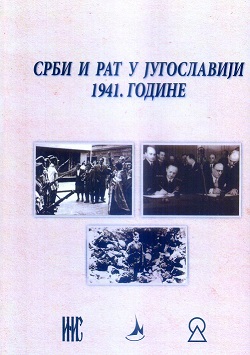Odnos vlasti Nezavisne Države Hrvatske prema srpskom stanovništvu u sjevernoj Dalmaciji od aprila 1941. do septembra 1943. godine
The Relationship of the Authorities of the Independent State of Croatia toward Serb Population in Northern Dalmatia, April 1941 – September 1943
Author(s): Nikica Barić
Subject(s): Civil Society, Political history, WW II and following years (1940 - 1949), Fascism, Nazism and WW II, Inter-Ethnic Relations, Sociology of Politics
Published by: Institut za noviju istoriju Srbije
Keywords: World War II; Independent State of Croatia; Dalmatia; Serbs in Dalmatia; David Sinčić;
Summary/Abstract: The article deals with the relations of the authorities of the Independent State of Croatia (ISC) toward the Serb population in northern Dalmatia. ISC was proclaimed by representatives of the Ustasha movement on April 10, 1941, several days after the beginning of Axis attack on Kingdom of Yugoslavia. Newly proclaimed Croatian state was forced to cede sizeable part of its Adriatic coast to its Italian ally. The border between Croatia and Italy was regulated by Rome agreements, signed by Benito Mussolini and Croatian head of state Ante Pavelić on May 18, 1941. Italians established their rule in the coastal area of northern and central Dalmatia while the remaining part of that region stayed within the Croatian state. Croatian authorities launched a policy of discrimination and violence against ethnic Serbs who lived in ISC in large number. Northern Dalmatian hinterland was also in large number inhabited by ethnic Serbs and they too were struck by terror of the new Croatian authorities. Between late May and late July of 1941 Ustasha detachments killed several hundreds Serbs in northern Dalmatia. In late July Serbs launched a large scale rebellion against Croatian authorities and rebels quickly took control over large areas of northern Dalmatia and neighbouring areas. Rebel would later split into two mutually opposed movements, the partisans led by Communist party of Yugoslavia and the Chetniks, who remained loyal to the royal Yugoslav government in exile. Italian army soon occupied whole Croatian coastal region under explanation that it has to secure the areas in the vicinity of the Italian annexed territories. In fact Italians could use this opportunity to greatly diminish the Croatian influence in the coastal region because it was obvious that ISC retained aspirations toward areas annexed by Italians according to the Rome agreements. For this reason Italians ordered Croatian army to withdraw
Book: Срби и рат у Југославији 1941. године
- Page Range: 533-556
- Page Count: 24
- Publication Year: 2014
- Language: Croatian
- Content File-PDF

